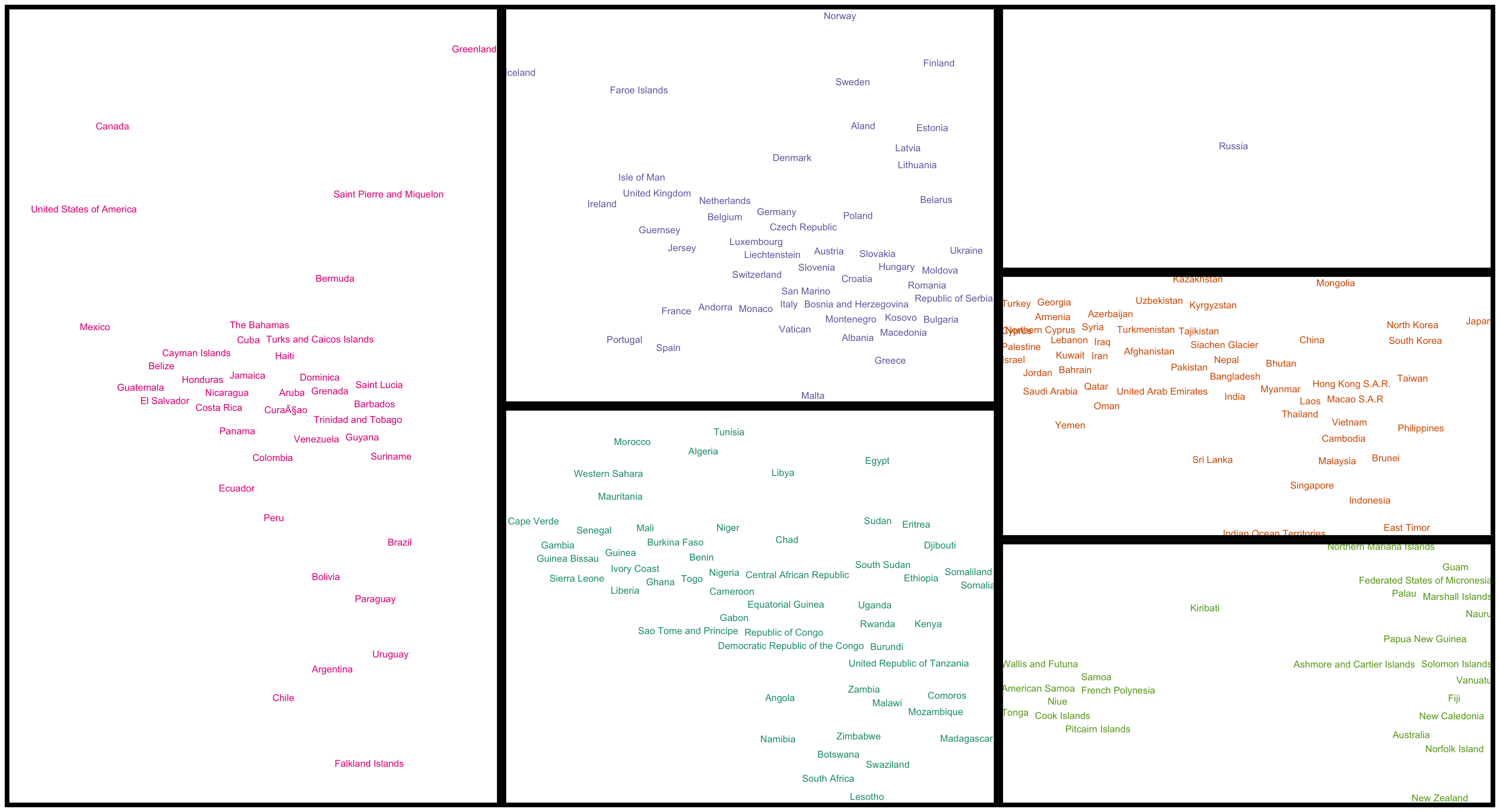Global map of country names
This post demonstrates the use of two very cool R packages - ggrepel and patchwork.
ggrepel deals with overlapping text labels (Code#1 at the bottom of this post):

patchwork is a very convenient new package for combining multiple different plots together (i.e. what we usually to use grid and gridExtra for).
More info:
To really demonstrate the power of them, let’s make a global map of country names using ggrepel:
library(tidyverse)
library(ggrepel)
library(patchwork)
# data from https://worldmap.harvard.edu/data/geonode:country_centroids_az8
orig_data = read_csv("country_centroids_az8.csv")
centroidsdata = orig_data %>%
select(country = admin, continent, lat = Latitude, lon = Longitude) %>%
filter(continent != "Seven seas (open ocean)" & continent != "Antarctica") %>%
mutate(continent = fct_collapse(continent, "Americas" = c("North America", "South America")))
head(centroidsdata)# # A tibble: 6 × 4
# country continent lat lon
# <chr> <fct> <dbl> <dbl>
# 1 Aruba Americas 12.5 -70.0
# 2 Afghanistan Asia 33.8 66.0
# 3 Angola Africa -12.3 17.5
# 4 Anguilla Americas 18.2 -63.1
# 5 Albania Europe 41.1 20.0
# 6 Aland Europe 60.2 20.0plot1 = centroidsdata %>%
ggplot(aes(x = lon, y = lat, label = country, colour = continent)) +
geom_text_repel(segment.alpha = 0) +
theme_void() +
scale_color_brewer(palette = "Dark2")
plot1# Warning: ggrepel: 24 unlabeled data points (too many
# overlaps). Consider increasing max.overlaps
Now this is very good already with hardly any overlapping labels and the world is pretty recognisable. And really, you can make this plot with just 2 lines of code:
ggplot(centroidsdata, aes(x = lon, y = lat, label = country)) +
geom_text_repel(segment.alpha = 0)So what these two lines make is already very amazing.
But I feel like Europe is a little bit misshapen and that the Caribbean and Africa are too close together. So I divided the world into regions (in this case same as continents except Russia is it’s own region - it’s just so big). Then wrote two functions that asked ggrepel to plot each region separately and use patchwork to patch each region together:
centroidsdata = centroidsdata %>%
mutate(region = continent %>% fct_expand("Russia")) %>%
mutate(region = replace(region, country == "Russia", "Russia"))
mapbounds = centroidsdata %>%
group_by(region) %>%
summarise(xmin = min(lon), xmax = max(lon), ymin = min(lat), ymax = max(lat))
create_labelmap = function(mydata, mycontinent, myforce = 1, mycolour = "black"){
mymapbounds = mapbounds %>%
filter(region == mycontinent)
mydata %>%
filter(region == mycontinent) %>%
ggplot(aes(x = lon, y = lat, label = country)) +
geom_text_repel(segment.alpha = 0, force = myforce, colour = mycolour) +
theme_void() +
theme(legend.position = "none") +
scale_y_continuous(limits = c(mymapbounds$ymin, mymapbounds$ymax)) +
scale_x_continuous(limits = c(mymapbounds$xmin, mymapbounds$xmax))
}
mycolours = RColorBrewer::brewer.pal(5,"Dark2")
make_world = function(mydata){
mydata = centroidsdata
afr = create_labelmap(mydata, "Africa", mycolour = mycolours[1])
ame = create_labelmap(mydata, "Americas", mycolour = mycolours[4])
asi = create_labelmap(mydata, "Asia", mycolour = mycolours[2])
eur = create_labelmap(mydata, "Europe", mycolour = mycolours[3])
rus = create_labelmap(mydata, "Russia", mycolour = mycolours[3])
oce = create_labelmap(mydata, "Oceania", mycolour = mycolours[5])
(ame + (eur / afr) + (rus / asi / oce)) + plot_layout(ncol = 3)
}
plot2 = make_world(centroidsdata)
plot2# Warning: ggrepel: 12 unlabeled data points (too many
# overlaps). Consider increasing max.overlaps
This gives continents a much better shape, but it does severaly misplace Polynesia. See if you can find where, e.g., Tonga is and where it should be.
To see what I did with patchwork there, let’s add black borders to each region (Code#2):
# Warning: ggrepel: 12 unlabeled data points (too many
# overlaps). Consider increasing max.overlaps
Code#1:
#devtools::install_github("slowkow/ggrepel")
#devtools::install_github("thomasp85/patchwork")
library(tidyverse)
library(ggrepel)
library(patchwork)
mydata = data_frame(x = c(1, 1.3), y = c(1, 1), mylabel = c("Point-1", "Point-2"))
p = mydata %>%
ggplot(aes(x, y, label = mylabel, colour = mylabel)) +
geom_point() +
coord_cartesian(xlim = c(-3, 3), ylim = c(-3, 3)) +
theme_bw() +
theme(legend.position = "none") +
scale_colour_viridis_d()
plot1 = p + geom_text() + ggtitle("geom_text()")
plot2 = p+ geom_text_repel() + ggtitle("geom_text_repel()")
plot1 + plot2Code#2:
create_labelmap = function(mydata, mycontinent, myforce = 1, mycolour = "black"){
mymapbounds = mapbounds %>%
filter(region == mycontinent)
mydata %>%
filter(region == mycontinent) %>%
ggplot(aes(x = lon, y = lat, label = country)) +
geom_text_repel(segment.alpha = 0, force = myforce, colour = mycolour) +
theme_void() +
theme(legend.position = "none") +
scale_y_continuous(limits = c(mymapbounds$ymin, mymapbounds$ymax)) +
scale_x_continuous(limits = c(mymapbounds$xmin, mymapbounds$xmax)) +
theme(panel.border = element_rect(colour = "black", fill=NA, size=5))
}
plot3 = make_world(centroidsdata)
plot3